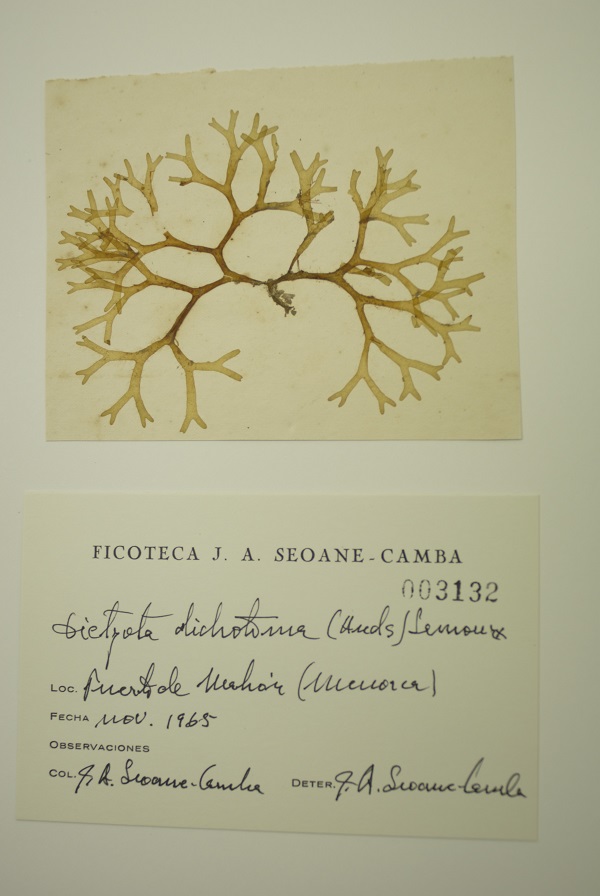CeDocBiV expands its algae collection with the herbarium of Professor Juan Antonio Seoane

The Plant Biodiversity Resource Centre (CeDocBiV) of the UB has expanded its algae collection with nearly 4,000 sheets of the main taxonomic groups of algae from the personal herbarium of Juan Antonio Seoane Camba, UB emeritus professor, who passed away in 2017, and considered a reference in the field of phycology in Spain. About 3,000 of these sheets correspond to samples collected or exchanged before the professor joined the UB in 1972. With the new material —a donation from Maruxa Suárez Cervera, retired professor of the UB and widow of Seoane— the CeDocBiV increases by 50% its algolological collection, which until now consisted of 8,000 herbarium sheets.

The Plant Biodiversity Resource Centre (CeDocBiV) of the UB has expanded its algae collection with nearly 4,000 sheets of the main taxonomic groups of algae from the personal herbarium of Juan Antonio Seoane Camba, UB emeritus professor, who passed away in 2017, and considered a reference in the field of phycology in Spain. About 3,000 of these sheets correspond to samples collected or exchanged before the professor joined the UB in 1972. With the new material —a donation from Maruxa Suárez Cervera, retired professor of the UB and widow of Seoane— the CeDocBiV increases by 50% its algolological collection, which until now consisted of 8,000 herbarium sheets.
An algological exhibition of international interest
The given herbarium contains about 2,300 specimens collected by the expert, and others from exchanges with other algologists. Although most of the sheets were collected during the second half of the 20th century, about 800 sheets date from the 19th century. The samples come mainly from the Iberian coasts, both Atlantic and Mediterranean, but also from other places along the European coastline —France, Ireland, etc.— and from more exotic places, such as Japan. It also includes material donated by the experts Jean Feldmann and Édouard Fischer-Piette (France), as well as specimens from North America —a donation from Professor William R. Taylor— and an outstanding collection of algae from Puerto Rico, the result of an exchange with Professor Manuel Díaz Piferrer.
Red algae (rhodophytes) are the most abundant taxonomic group in the new herbarium —some 2,500 sheets— with different specimens of the genus Gelidium —on which Seoane Camba was an expert— such as Gelidium cantabricum Seoane-Camba and Gelidium canariense (Grunow) Seoane-Camba ex Haroun, Gil-Rodríguez, Díaz de Castro & Prudʼhomme van Reineet al.
In the case of brown algae (phaeophytes) —with more than 800 specimens— the best represented species belong to the orders of Fucales (250) and Dictyotales (150). There are also more than 400 specimens of green algae (chlorophytes) and more than 100 cyanophytes.
The algae collection, which was deposited in Bayona (Galicia), was collected and analysed by Professor Amelia Gómez Garreta, director of the CeDocBiV BCN herbarium and member of the Faculty of Pharmacy and Food Sciences, in collaboration with Josep Vicens Fandos, curator of the BCN Herbarium and associate professor of the same faculty.
Professor Juan Antonio Seoane Camba, a role model and pioneer in marine algaeology
Juan Antonio Seoane Camba (1933-2017) is considered a pioneer of marine algology studies and the driving force behind a great scientific expertise that still endures today. He completed his primary and secondary education in Galicia, and after studying the common course of Science at the University of Santiago de Compostela, he enrolled at the University of Barcelona, where he graduated in 1958. His doctoral thesis, supervised by Professor Francisco García del Cid at the former Fisheries Research Institute, confirmed his interest in the benthic algae of the peninsula. In 1971, he was appointed Professor of Botany at the Faculty of Pharmacy of the University of Barcelona, a position he got by transfering from Madrid. In parallel to his teaching and research activities, he was also vice-dean of the Faculty of Pharmacy (1980-1982), director of the Department of Botany (1971-1986) and of the Department of Natural Products, Plant Health Biology and Soil Science (1986-1989).
The chair of Botany directed by Seoane Camba became a reference in the study of the marine benthic flora of the peninsular coast, which spurred the progress of research in phycology during the second half of the 20th century. In the university context, Seoane Camba also promoted the creation of new research groups on marine algaeology, freshwater algaeology, palynology, ethnobotany, biosystematics of cormophytes and other related areas.
